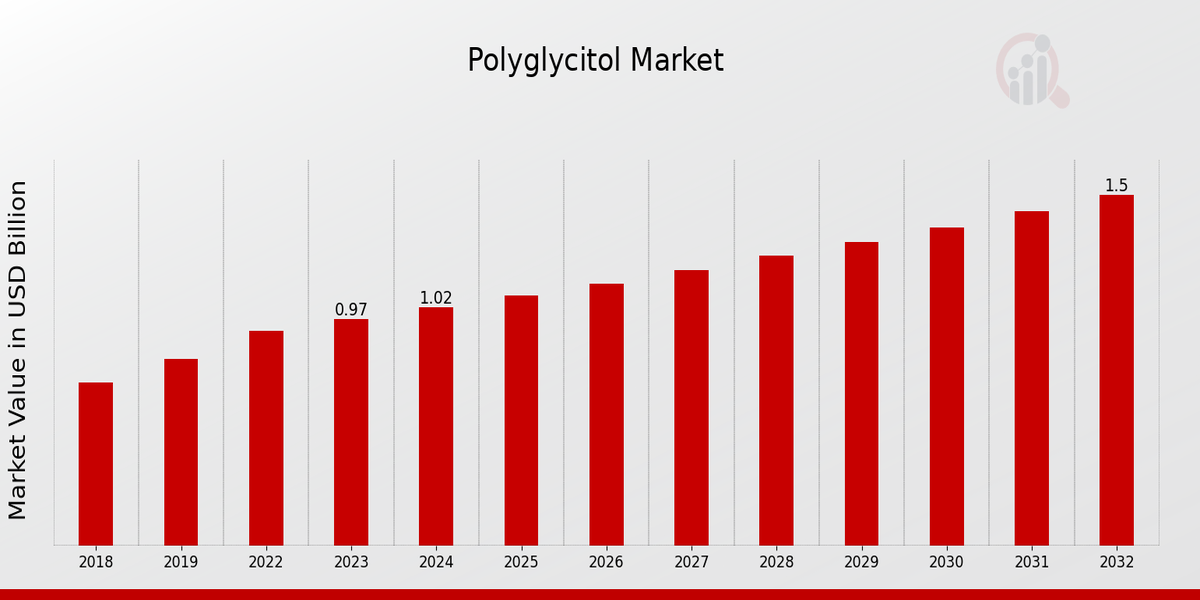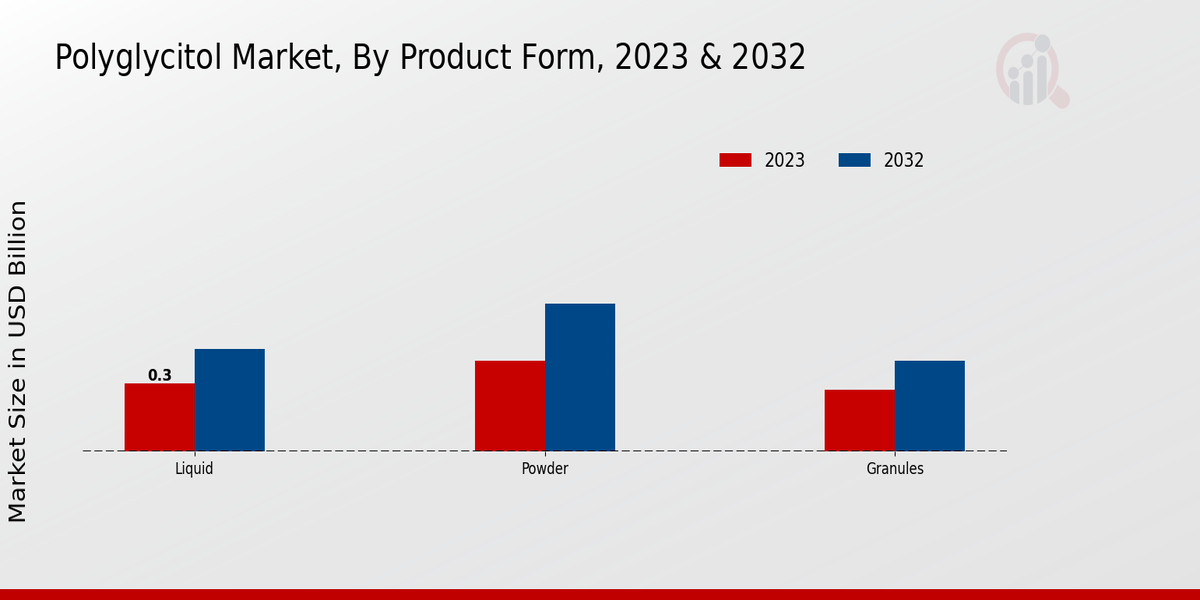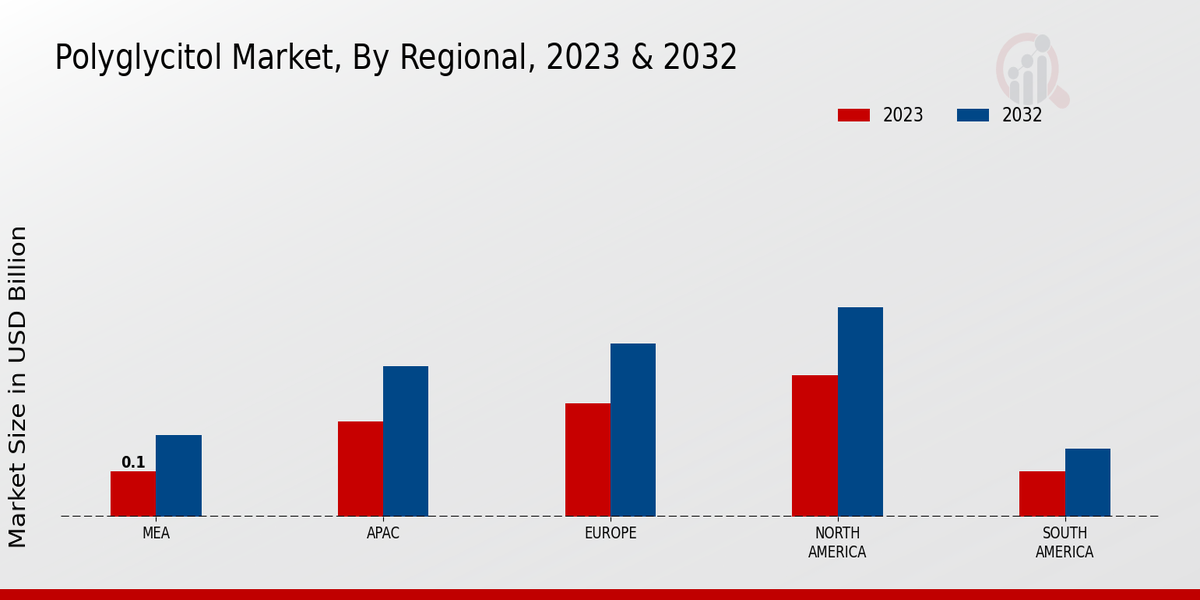Global Polyglycitol Market Overview
As per MRFR analysis, the Polyglycitol Market Size was estimated at 0.92 (USD Billion) in 2022.
The Polyglycitol Market Industry is expected to grow from 0.97(USD Billion) in 2023 to 1.5 (USD Billion) by 2032. The Polyglycitol Market CAGR (growth rate) is expected to be around 4.95% during the forecast period (2024 - 2032).
Key Polyglycitol Market Trends Highlighted
The Polyglycitol Market is experiencing significant growth driven by a combination of factors, including the rising demand for sugar substitutes and the increasing awareness of health and wellness among consumers. The versatility of polyglycitol as a low-calorie sweetener makes it a preferred ingredient in various food and beverage applications. Additionally, its use in pharmaceuticals and personal care products is expanding, further boosting its market presence. The growing trend towards clean-label products is also encouraging manufacturers to replace artificial sweeteners with safe, natural alternatives like polyglycitol, thereby amplifying its adoption across multiple sectors.Opportunities in the Polyglycitol Market are abundant, particularly in emerging economies where changing lifestyles and dietary preferences are leading to a shift towards healthier food choices. The introduction of innovative products incorporating polyglycitol, such as gluten-free and organic offerings, can capture the attention of health-conscious consumers. Furthermore, the increasing regulatory support for low-calorie sweeteners presents a favorable environment for market expansion.In recent times, the market has observed a notable trend towards sustainability, with manufacturers seeking to source raw materials responsibly and adopt eco-friendly production processes. This has led to a greater emphasis on research and development, focusing on enhancing the functional properties of polyglycitol. The rise of e-commerce platforms for food and health products is also transforming the distribution landscape, enabling greater consumer access and awareness of polyglycitol and its applications. As the market continues to evolve, the interplay of these trends will likely shape its future dynamics and create a multitude of avenues for growth and development.

Source: Primary Research, Secondary Research, MRFR Database and Analyst Review
Polyglycitol Market Drivers
Increasing Demand from Food and Beverage Industry
The food and beverage industry is witnessing a significant shift towards the use of natural and low-calorie sweeteners, propelling the growth of the Polyglycitol Market Industry. Polyglycitol, being sugar alcohol, offers lower calories compared to traditional sugars, making it an attractive alternative for manufacturers aiming to meet the rising consumer demand for healthier food products. This shift is driven by consumers becoming more health-conscious and seeking reductions in sugary intake, thereby spurring product innovations designed to deliver sweetness without the associated calories.The entrenched presence of polyglycitol in various applications such as confectionery, baked goods, dairy products and sugar substitutes is indicative of its growing relevance. Additionally, the versatility of polyglycitol, being suitable for numerous formulations without compromising taste or texture, enhances its appeal to food manufacturers. As the global market valuation continues to grow, it is expected that more key players will invest in developing polyglycitol-based products to cater to this expanding demographic.This trend is also supported by regulatory agencies, which are increasingly endorsing the use of alternative sweeteners due to their potential health benefits. Thus, the convergence of these factors is anticipated to significantly drive the growth of the Polyglycitol Market Industry over the coming years.
Rising Awareness of Health and Wellness
The growing awareness of health and wellness among consumers has resulted in a notable shift towards healthier food products, consequently boosting the Polyglycitol Market Industry. As people become more informed about the potential health risks associated with excessive sugar consumption, the demand for sugar substitutes, including polyglycitol, is on the rise. This trend is particularly prominent in regions experiencing an increase in lifestyle-related health issues, such as obesity and diabetes.With consumers actively seeking out products that promote better health and well-being, manufacturers are increasingly incorporating polyglycitol into their offerings to attract these health-conscious shoppers. As a result, the market for polyglycitol is projected to grow as more companies aim to align with consumer preferences for functional and healthier ingredients.
Technological Advancements in Manufacturing
Innovations and advancements in the manufacturing processes of polyglycitol are contributing to the expansion of the Polyglycitol Market Industry. Enhanced production techniques allow for improved efficiency and reduced costs, making it more feasible for manufacturers to scale up polyglycitol production. These technological improvements not only help meet increasing demand but also ensure the consistent quality and purity of the product. As manufacturing processes evolve and optimize, the availability of polyglycitol in the market is expected to increase, driving greater adoption across various industries, particularly in food and personal care applications.This trend toward technological progress is considered a pivotal factor propelling the growth of the Polyglycitol Market Industry.
Polyglycitol Market Segment Insights
Polyglycitol Market Product Form Insights
The Polyglycitol Market, primarily segmented by Product Form, is expected to showcase a steady growth trajectory as it caters to various industries, including food, pharmaceuticals and personal care. In 2023, the overall market is valued at 0.97 USD Billion, with significant contributions from different product forms shaping the market landscape. The value of the Liquid form in 2023 stands at 0.3 USD Billion, reflecting its critical role in applications requiring solubility and uniformity, making it a preferred choice for formulations that benefit from fluid incorporation. As the market progresses towards 2032, the Liquid segment is projected to grow to 0.45 USD Billion, highlighting the increasing preference for convenient application forms.
Simultaneously, the Powder form emerges as a dominant contributor, valued at 0.4 USD Billion in 2023. Its significance stems from its versatility in both production and application, often utilized in dry formulations where stability and potency are paramount. This segment is anticipated to reach 0.65 USD Billion by 2032, as industries continue to lean towards powdered products for their ease of storage and transport. The Granules segment, while valued at 0.27 USD Billion in 2023, represents a smaller portion of the market compared to the Liquid and Powder forms. However, its anticipated growth to 0.4 USD Billion in 2032 underscores its relevance in providing a balanced delivery method for active ingredients, catering to niche applications where the granulation process offers advantages.
The majority holding in the Polyglycitol Market is seen in the Powder and Liquid segments, which dominate due to their broad compatibility and extensive applications. Market trends indicate a higher adoption of powdered forms, driven by their favorable properties in formulations, thus impacting the overall market growth positively. Challenges include the need for regulatory compliance and product standardization, which can affect product development timelines, yet these hurdles present opportunities within the framework of innovation and new product development initiatives aimed at optimizing the applications of different product forms.
The intersection of rising consumer demand and technological advancements in production methods is likely to propel the market forward, as depicted in the Polyglycitol Market data. This market presents a unique blend of opportunities, driven by the significant growth potential within the Powder and Liquid segments, marking their importance in the overall Polyglycitol Market industry.

Source: Primary Research, Secondary Research, MRFR Database and Analyst Review
Polyglycitol Market Application Insights
This market includes various applications such as Food and Beverage, Pharmaceuticals, Cosmetics, Personal Care and Industrial. The Food and Beverage sector is particularly notable for its increasing demand for sugar substitutes and low-calorie sweeteners, highlighting its significant contribution to the market. The Pharmaceutical industry benefits from polyglycitol as an excipient in formulations, emphasizing its vital role in drug delivery and patient compliance.Additionally, the Cosmetics and Personal Care segments leverage polyglycitol for its moisture-retaining properties, enhancing product efficacy and consumer satisfaction. The Industrial application is gaining traction as manufacturers seek sustainable and versatile ingredients in production processes. Combined, these applications reflect the diverse potential of the Polyglycitol Market, driven by trends favoring health and wellness, innovation, and sustainability. With expected market growth through to 2032, the Polyglycitol Market industry is positioned for steady advancement, influenced by consumer preferences and regulatory support for safe and functional ingredients.
Polyglycitol Market Functionality Insights
This segment encompasses diverse functionalities, including Sugar Substitute, Humectant, Thickener and Stabilizer, each playing a crucial role in various applications. Sugar substitutes are increasingly sought after due to the rising health consciousness among consumers, driving demand for lower-calorie alternatives in food and beverage products. Humectants are essential for enhancing moisture retention in cosmetics and personal care products, contributing to product effectiveness and longevity.Thickeners play a pivotal role in achieving the desired texture and consistency in a wide array of products, from sauces to dairy items, thus ensuring consumer satisfaction. Meanwhile, stabilizers are significant in maintaining product integrity and quality during storage and transportation, making them indispensable in the food industry. The projected growth in the Polyglycitol Market is further fueled by increasing disposable incomes and modernization in food processing techniques, highlighting the importance of each functional role in adapting to market demands.Overall, the Functionality segment showcases a robust landscape reflected in the Polyglycitol Market statistics, driven by innovation and changing consumer preferences.
Polyglycitol Market End User Insights
The End User segment comprises key players such as Manufacturers, Retailers, Food Processors and Pharmaceutical Companies, each playing a crucial role in market dynamics. In particular, Manufacturers dominate this segment, as they are responsible for producing various formulations of polyglycitol used across different industries. Meanwhile, Retailers are essential in disseminating these products to the broader market, ensuring accessibility for consumers.Food Processors also hold a significant share as polyglycitol is increasingly used as a sweetener and bulking agent in food products, catering to the demand for healthier alternatives. Lastly, Pharmaceutical Companies leverage polyglycitol due to its properties beneficial for drug delivery systems, thereby heightening its importance in the healthcare sector. The ongoing trends in clean-label products and natural ingredients are likely to propel the market growth, presenting numerous opportunities for stakeholders across these End User categories.Challenges such as regulatory hurdles and fluctuating raw material prices may impact the overall market statistics, but with strategic approaches, these can be mitigated effectively.
Polyglycitol Market Regional Insights
The Polyglycitol Market has shown impressive growth across various regions, with a projected overall market value reaching 0.97 USD Billion in 2023 and expected to rise to 1.5 USD Billion by 2032. Among the regions, North America leads with a valuation of 0.31 USD Billion in 2023, reflecting a significant demand for polyglycitol in food and pharmaceutical applications. Europe closely follows, valued at 0.25 USD Billion, driven by rising health consciousness and demand for sugar alternatives. The Asia Pacific region, valued at 0.21 USD Billion, is also notable, with increasing applications in personal care and cosmetics, indicating a growing trend towards using polyglycitol as a multifunctional agent.The Middle East and Africa accounts for 0.1 USD Billion, showing emerging potential as markets for food additives expand, while South America, valued at 0.1 USD Billion, is gradually adapting to these trends, focusing on health-related products. Overall, the Polyglycitol Market segmentation reveals a landscape where North America and Europe dominate, but with increasing growth opportunities in Asia Pacific and other regions, driven by a shift in consumer preferences towards healthier alternatives.

Source: Primary Research, Secondary Research, MRFR Database and Analyst Review
Polyglycitol Market Key Players and Competitive Insights
The Polyglycitol Market is characterized by a dynamic competitive landscape, with various players vying for market share through innovative product offerings and strategic partnerships. As a versatile ingredient, polyglycitol finds applications across multiple sectors, including food, pharmaceuticals, personal care, and industrial processes. The market's growth is spurred by increasing consumer demand for safe, non-toxic alternatives, propelling manufacturers to focus on sustainability and quality. Competitors are leveraging advancements in technology and manufacturing processes to enhance product efficiency while maintaining cost-effectiveness, enabling them to cater to a growing clientele that values both performance and safety in the products they choose. Understanding the competitive dynamics requires a close analysis of the key players, their market strategies and the overall demand trends that shape the industry.DuPont has established a strong foothold in the Polyglycitol Market, primarily due to its commitment to innovation and high-quality production. The company benefits from its extensive expertise in chemical engineering and research, which allows it to develop advanced polyglycitol products that meet the diverse needs of customers. DuPont's reputation for reliability and excellence contributes to its competitive advantage, making it a preferred choice among manufacturers looking for premium-grade polyglycitol. Additionally, DuPont's strong distribution network and global outreach play crucial roles in enhancing its market presence, enabling the company to effectively meet regional demands and quickly respond to market changes. The firm’s focus on sustainable practices further resonates with environmentally conscious consumers, positioning it as a leader in the segment and bolstering its brand's value.BASF SE also commands a significant presence in the Polyglycitol Market, recognized for its extensive portfolio and commitment to quality. The company harnesses its deep understanding of market dynamics and customer preferences, allowing it to deliver polyglycitol solutions that are not only effective but also compliant with stringent regulatory standards. BASF SE's strengths lie in its robust research and development capabilities, which facilitate ongoing product innovation and adaptation to evolving industry trends. Moreover, BASF SE's strategic alliances and partnerships enhance its resource capabilities and broaden its customer base, allowing for greater penetration of the market. Its emphasis on sustainability and resource stewardship resonates with stakeholders and consumers alike, ensuring that the company remains a strong competitor in this segment. The consistent focus on quality and innovation positions BASF SE as a key player, further solidifying its reputation in the Polyglycitol Market.
Key Companies in the Polyglycitol Market Include
- DuPont
- BASF SE
- Mannkind Corporation
- Siegfried AG
- Kraton Corporation
- Mitsubishi Chemical Corporation
- Evonik Industries
- Hawkins, Inc.
- Holland Company
- Glenvista
- Sabuco
- BASF
- Cargill
- Ingredion Incorporated
Polyglycitol Market Industry Developments
Recent developments in the Polyglycitol Market reflect a growing interest in its applications across various industries, particularly in food, pharmaceuticals, and cosmetics. With an increasing emphasis on clean-label products, polyglycitol, recognized for its sweetness and low-calorie content, is becoming a preferred ingredient in sugar substitutes, driving significant demand.
Additionally, advancements in production technologies are enhancing the efficiency and sustainability of polyglycitol manufacturing processes. Collaborations and partnerships among key players are also on the rise, aiming to expand product portfolios and strengthen market positions. Furthermore, regulatory changes in food safety standards are prompting manufacturers to innovate in formulation, positioning polyglycitol as a versatile ingredient. As consumers become more health-conscious and demand transparency in ingredient sourcing, the market outlook remains optimistic, with projections indicating steady growth leading up to 2032. The evolving landscape underscores the importance of adaptability and responsiveness to consumer trends, placing significant pressure on manufacturers to remain competitive while meeting diverse customer preferences.
Polyglycitol Market Segmentation Insights
-
Polyglycitol Market Product Form Outlook
-
Polyglycitol Market Application Outlook
- Food and Beverage
- Pharmaceuticals
- Cosmetics
- Personal Care
- Industrial
-
Polyglycitol Market Functionality Outlook
- Sugar Substitute
- Humectant
- Thickener
- Stabilizer
-
Polyglycitol Market End User Outlook
- Manufacturers
- Retailers
- Food Processors
- Pharmaceutical Companies
-
Polyglycitol Market Regional Outlook
- North America
- Europe
- South America
- Asia Pacific
- Middle East and Africa
| Report Attribute/Metric |
Details |
| Market Size 2022 |
0.92(USD Billion) |
| Market Size 2023 |
0.97(USD Billion) |
| Market Size 2032 |
1.5(USD Billion) |
| Compound Annual Growth Rate (CAGR) |
4.95% (2024 - 2032) |
| Report Coverage |
Revenue Forecast, Competitive Landscape, Growth Factors, and Trends |
| Base Year |
2023 |
| Market Forecast Period |
2024 - 2032 |
| Historical Data |
2019 - 2023 |
| Market Forecast Units |
USD Billion |
| Key Companies Profiled |
DuPont, BASF SE, Mannkind Corporation, Siegfried AG, Kraton Corporation, Mitsubishi Chemical Corporation, Evonik Industries, Hawkins, Inc., M. Holland Company, Glenvista, Sabuco, BASF, Cargill, Ingredion Incorporated |
| Segments Covered |
Product Form, Application, Functionality, End User, Regional |
| Key Market Opportunities |
1. Rising demand in the food industry 2. Growth in pharmaceutical applications 3. Increasing use of personal care products 4. Expanding market in cosmetics 5. Advancements in biodegradable alternatives |
| Key Market Dynamics |
1. Growing demand in the food industry 2. Rising preference for sugar alternatives 3. Increasing applications in pharmaceuticals 4. Expanding use of personal care products 5. Shift towards clean-label ingredients |
| Countries Covered |
North America, Europe, APAC, South America, MEA |
Frequently Asked Questions (FAQ) :
The Polyglycitol Market is expected to be valued at 1.5 USD Billion in 2032.
The expected CAGR for the Polyglycitol Market from 2024 to 2032 is 4.95.
North America is projected to hold the largest market share in the Polyglycitol Market with a value of 0.46 USD Billion in 2032.
In 2032, the Powder segment is expected to be valued at 0.65 USD Billion, Liquid at 0.45 USD Billion, and Granules at 0.4 USD Billion.
The Polyglycitol Market in Europe is expected to be valued at 0.38 USD Billion by 2032.
Major players in the Polyglycitol Market include DuPont, BASF SE, Mannkind Corporation, and Evonik Industries.
The Polyglycitol Market in the Asia-Pacific region is expected to reach 0.33 USD Billion by 2032.
The South American Polyglycitol Market is expected to grow from 0.1 USD Billion in 2023 to 0.15 USD Billion by 2032.
The Polyglycitol Market in the MEA region is anticipated to be valued at 0.18 USD Billion by 2032.
The growing use of Polyglycitol in food, pharmaceuticals, and personal care products is driving the market's growth.





























